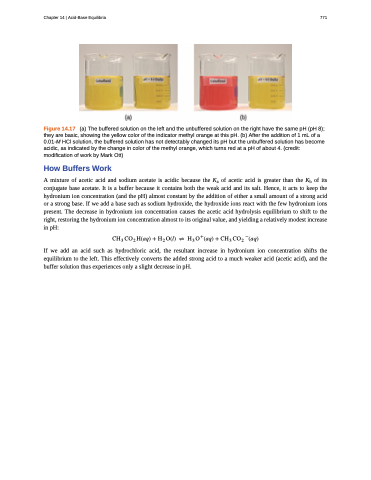Page 781 - Chemistry--atom first
P. 781
Chapter 14 | Acid-Base Equilibria 771
Figure 14.17 (a) The buffered solution on the left and the unbuffered solution on the right have the same pH (pH 8); they are basic, showing the yellow color of the indicator methyl orange at this pH. (b) After the addition of 1 mL of a 0.01-M HCl solution, the buffered solution has not detectably changed its pH but the unbuffered solution has become acidic, as indicated by the change in color of the methyl orange, which turns red at a pH of about 4. (credit: modification of work by Mark Ott)
How Buffers Work
A mixture of acetic acid and sodium acetate is acidic because the Ka of acetic acid is greater than the Kb of its conjugate base acetate. It is a buffer because it contains both the weak acid and its salt. Hence, it acts to keep the hydronium ion concentration (and the pH) almost constant by the addition of either a small amount of a strong acid or a strong base. If we add a base such as sodium hydroxide, the hydroxide ions react with the few hydronium ions present. The decrease in hydronium ion concentration causes the acetic acid hydrolysis equilibrium to shift to the right, restoring the hydronium ion concentration almost to its original value, and yielding a relatively modest increase in pH:
������������������ � ��������������������
If we add an acid such as hydrochloric acid, the resultant increase in hydronium ion concentration shifts the equilibrium to the left. This effectively converts the added strong acid to a much weaker acid (acetic acid), and the buffer solution thus experiences only a slight decrease in pH.


